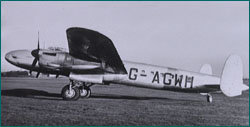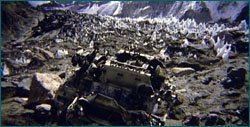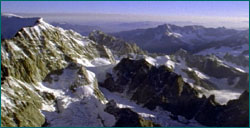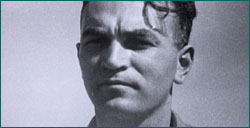 |
 |
|  Stardust
Stardust
|
Solve the Mystery of STENDEC
1947 Official Accident Report
Below is the 1947 official accident report describing what was known at the
time about Stardust, its crew, and its mysterious disappearance. The
report was published in 1948 by His Majesty's Stationery Office in England and
is reproduced here with kind permission of Crown Copyright.
[page 1]
Ministry of Civil Aviation
Civil Aircraft Accident
Report on the accident to Lancastrian III G-AGWH which occurred on
2nd August 1947 in the Andes Mountains South America
London: His Majesty's Stationery Office
1948
[page 2]
22nd December 1947
Ministry Of Civil Aviation
Ariel House, Strand
London, W.C.2
The Minister of Civil Aviation
My Lord,
I have the honour to submit herewith my Report on the circumstances of the
accident to Lancastrian Mk. III. G-AGWH, which occurred in the Andes Mountains,
South America, on 2nd August 1947.
I have the honour to be,
My Lord,
Your Obedient Servant
Vernon Brown
Air Commodore
Chief Inspector of Accidents
[page 3]
Accidents Investigation Branch
Report No. C.A. 106
AIRCRAFT:
Lancastrian Mk. III
British. G-AGWH
 One of Stardust's engines high on Mt. Tupangato
in the southern Andes.
One of Stardust's engines high on Mt. Tupangato
in the southern Andes.
|
|
ENGINES:
Four Rolls-Royce Merlins.
One T 24/2 type
One 502 type
Two 500-2 type
OWNERS:
British South American Airways Corperation
CREW:
Commander Mr. R. J. Cook (Missing since 2nd August 1947)
First Officer Mr. N. H. Cook (Missing since 2nd August 1947)
Second Officer Mr. D. Checklin (Missing since 2nd August
1947)
Number Of Passengers: Six (Missing since 2nd August 1947)
PLACE OF ACCIDENT:
Aircraft wreckage not located to date, but considered to be in the Andes
Mountains probably within 40 miles eastward of Santiago-de-Chile.
DATE AND TIME:
On 2nd August 1947. Presumed to be at between 1741 hrs. and 1745
hrs.
All times given in this report are G.M.T.
1. NOTIFICATION
By telephone from B.S.A.A.C., London, at 1100 hrs. on August 3rd
1947. The vicinity of the accident was visited August 31st 1947. In
the meantime information was received from the British Air Attaches in
Argentina and Chile causing the Minister of Civil Aviation to call for an
investigation.
|  The Andes lie directly in the path of any flight from
Buenos Aires, Argentina to Santiago, Chile.
The Andes lie directly in the path of any flight from
Buenos Aires, Argentina to Santiago, Chile.
|
2. CIRCUMSTANCES OF THE ACCIDENT
The aircraft was completing the last leg from Buenos Aires to Santiago of a
scheduled flight (C.S.59) from London to Santiago. The flight from London to
Buenos Aires was carried out in a York aircraft and at Buenos Aires the customary
transfer was made to a Lancastrian to facilitate the crossing of the Andes
Mountains.
There are three recognized trans-Andean routes, viz. Direct, North or South
diversionary routes. For all general purposes they may be described as
follows:
(a) Central and most direct, Buenos Aires-Santiago, 30 nautical miles South of
Mendoza or via Mendoza.
(b) Southern, Buenos Aires-Santiago via Planchon.
(c) Northern, Buenos Aires-Santiago via San Juan.
Both in London and Buenos Aires the pilot had been briefed against taking the
central route if bad weather prevailed.
The flight plan was made out for the route Buenos Aires-Santiago via Mendoza.
The amount of fuel carried was 1,380 gallons, giving an estimated duration of 6
hours 30 minutes. The estimated time of the flight was 3 hours 45 minutes. By
keeping to the flight plan and arriving over Mendoza at 18,000 feet the
distance of 526 nautical miles from Buenos Aires to Mendoza should have taken 3
hours 12 minutes. The remaining distance of 106 miles from Mendoza to Santiago
should have taken 33 minutes at proposed height of 26,000 feeet. The aircraft
departed Buenos Aires at 1346 hrs. on August 2nd 1947, and was
reported as follows:
1507 hrs. 33°55' S. 62°33' W. Height 10,000 feet, course 286°,
speed 196 knots, E.T.A. Santiago 1730 hrs.
 Peter Young, one of the passengers on
Stardust's ill-fated final flight.
Peter Young, one of the passengers on
Stardust's ill-fated final flight.
|
|
[page 4]
1600 hrs. 33°25' S. 65°30' W. Height 10,000 feet, course 282°,
speed 196 knots, E.T.A. Santiago 1730 hrs.
1700 hrs. 32°50' S. 68°30' W. Height 20,000 feet, ascending to 24,000
feet, speed 194 knots, E.T.A. Santiago 1743 hrs.
1733 hrs. E.T.A. Santiago 1745 hrs.
1741 hrs. A signal was sent out by the aircraft, E.T.A. Santiago 1745 hrs.
ending with "STENDEC."
The 1741 hrs. signal was received by Santiago only 4 minutes before the E.T.A.
The Chilean Air Force operator at Santiago states that the reception of the
signal was loud and clear but that it was given out very fast. Not
understanding the word "STENDEC" he queried it and had the same word repeated
by the aircraft twice in succession.
A solution to the word "STENDEC" has not been found.
From this time on nothing further was heard from the aircraft and no contact
was made with the control tower over Santiago. All further calls were
unanswered.
3. FURTHER DETAILS
(a) The Aircraft
The aircraft was manufactured by A.V. Roe & Co., Ltd., Woodford, and was
completed and test flown in December 1945. It was taken over by the British
South American Airways Corporation in January 1946. In February 1946 it was
transferred by air to A.V. Roe & Co., at Waddington for modifications to be
carried out; it was test flown in February 1946 and delivered to B.S.A.A.C. at
Heathrow by air the same month. All relevant modifications and replacements had
been carried out. Its service on routes commenced in March 1946. The total time
flown up to the last entry in the log book on July 22nd 1947 was
1655 hours 15 minutes.
Continue: The Engines
Solve the Mystery of STENDEC |
Mysterious Plane Crashes
Reading the Wreckage |
Inside the Jet Stream |
Resources
Transcript |
Site Map |
Vanished! Home
Editor's Picks |
Previous Sites |
Join Us/E-mail |
TV/Web Schedule
About NOVA |
Teachers |
Site Map |
Shop |
Jobs |
Search |
To print
PBS Online |
NOVA Online |
WGBH
© | Updated January 2001
|
|
|